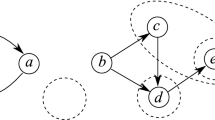Abstract
The symmetric maximum, denoted by Ⓥ, is an extension of the usual maximum ∨ operation so that 0 is the neutral element, and − x is the symmetric (or inverse) of x, i.e., x Ⓥ ( − x) = 0. However, such an extension does not preserve the associativity of ∨. This fact asks for systematic ways of parenthesing (or bracketing) terms of a sequence (with more than two arguments) when using such an extended maximum. We refer to such systematic (predefined) ways of parenthesing as computation rules. As it turns out there are infinitely many computation rules, each of which corresponds to a systematic way of bracketing arguments of sequences. Essentially, computation rules reduce to deleting terms of sequences based on the condition x Ⓥ ( − x) = 0. This observation gives raise to a quasi-order on the set of such computation rules: say that rule 1 is below rule 2 if for all sequences of numbers, rule 1 deletes more terms of the sequence than rule 2. In this paper we present a study of this quasi-ordering of computation rules. In particular, we show that the induced poset of all equivalence classes of computation rules is uncountably infinite, has infinitely many maximal elements, has infinitely many atoms, and it embeds the powerset of natural numbers ordered by inclusion.
Similar content being viewed by others
References
Blyth, T.S.: Lattices and Ordered Algebraic Structures. Springer (Universitext), London (2005)
De Baets, B., Fodor, J., Grabisch, M.: The quest for rings on bipolar scales. Int. J. Uncertain. Fuzziness Knowl.-Based Syst. 12(4), 499–512 (2004)
Caspard, N., Leclerc, B., Monjardet, B.: Les Ensembles Ordonnés Finis: Concepts, Résultats et Usages. Springer (2007)
Davey, B.A., Priestley, H.A.: Introduction to Lattices and Order. Cambridge University Press, Cambridge, UK (2002)
Grabisch, M.: The symmetric Sugeno integral. Fuzzy Sets Syst. 139, 473–490 (2003)
Grabisch, M.: The Möbius transform on symmetric ordered structures and its application to capacities on finite sets. Discrete Math. 287(1–3), 17–34 (2004)
Grabisch, M.: Aggregation on bipolar scales. In: de Swart, H., Orlowska, E., Roubens, M., Schmidt, G. (eds.) Theory and Applications of Relational Structures as Knowledge Instruments II. Lecture Notes in Artificial Intelligence, pp. 355–371. Springer (2006)
Grabisch, M., Marichal, J.-L., Mesiar, R., Pap, E.: Aggregation functions. Encyclopedia of Mathematics and its Applications 127. Cambridge University Press, Cambridge (2009)
Pap, E., Štajner-Papuga, I.: Pseudo-integral based on non-associative and non-commutative pseudo-addition and pseudo-multiplication. Int. J. Uncertain. Fuzziness Knowl.-Based Syst. 9(2), 159–167 (2001)
Author information
Authors and Affiliations
Corresponding author
Rights and permissions
About this article
Cite this article
Couceiro, M., Grabisch, M. On the Poset of Computation Rules for Nonassociative Calculus. Order 30, 269–288 (2013). https://doi.org/10.1007/s11083-011-9243-z
Received:
Accepted:
Published:
Issue Date:
DOI: https://doi.org/10.1007/s11083-011-9243-z




